Poo From Lil BUB Leads To An Amazing Discovery
Jennifer Gardy, Microbiologist
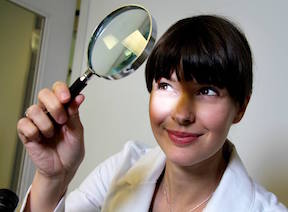 Microbiologist and TV Host Jennifer Gardy has been collecting cat poop as part of a biome-mapping project. Viral sensation Lil BUB even donated a sample that led to the discovery of 22 new microorganisms. Jennifer will explain what that means to you and me.
Microbiologist and TV Host Jennifer Gardy has been collecting cat poop as part of a biome-mapping project. Viral sensation Lil BUB even donated a sample that led to the discovery of 22 new microorganisms. Jennifer will explain what that means to you and me.
Jennifer is a microbiologist who studies poop, which she says is probably her favorite subject matter. She works at the BC Center for Disease Control at the University of British Columbia. However, she tells us she also has a little side hustle as well. She does a bit of science journalism and hosts a documentary series in Canada. Once or twice a season she will take over a show called The Nature of Things where they do different episodes about different topics. Recently, they did one all about poop. For one of the stories, Jennifer swallowed a tiny little camera, which she says was her own version of Fantastic Voyage. She then got to see exactly what her gut looks like inside, including where poop comes from.
While this video never went viral, Jennifer said her parents were pretty proud of it. Fortunately, Jennifer did not have to retrieve the camera when it made its pass. She said that's the beauty of this technology, it's cheap enough that you can flush it away and not really have to worry about getting an expensive camera back. It's quite disposable.
An electron micrograph was then taken in high resolution of the microbes that live in Jennifer's gut. Now, she has a family photo of all of the different bacteria that lives inside her. Jennifer can now show people her two dogs, her one cat and her gut bacterium.
Jennifer has been involved with a company called AnimalBiome for several years now. It originally started out as an Internet funded, citizen science driven project called KittyBiome. KittyBiome was launched a few years ago with a goal to get people to send in samples of their cat's poop. They would then use a microbiological technique to take a census of all the different microbes, all the different microbial species that were present in that poop. It's kind of like figuring out your pet's micro biome. They wanted to get a little publicity for it and do something fun. So they thought, hey, they should get a famous Internet cat's poop.
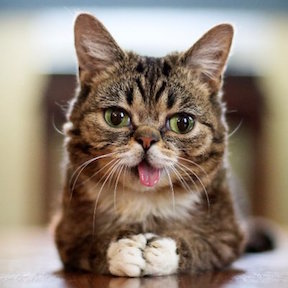 Holly Ganz is the founder of AnimalBiome who drove the KittyBiome initiative. She asked around the famous Internet cat community for poop. Lil BUB's owner then volunteered her poop. They did an initial analysis to see what types of microbes were in there. It turns out they had just finished collaborating with a company in Seattle where they took Lil BUB's poop sample even further. Not only did they see what microbes were in there, but they were also able to assemble their entire genomes. That's basically assembling their entire DNA instruction manual, something that nobody had really done before. They were then able to actually discover 13 new bacterial species inside Lil BUB's colon, which Jennifer says was pretty amazing.
Holly Ganz is the founder of AnimalBiome who drove the KittyBiome initiative. She asked around the famous Internet cat community for poop. Lil BUB's owner then volunteered her poop. They did an initial analysis to see what types of microbes were in there. It turns out they had just finished collaborating with a company in Seattle where they took Lil BUB's poop sample even further. Not only did they see what microbes were in there, but they were also able to assemble their entire genomes. That's basically assembling their entire DNA instruction manual, something that nobody had really done before. They were then able to actually discover 13 new bacterial species inside Lil BUB's colon, which Jennifer says was pretty amazing.
So what does this information mean to then general public and their animals? Jennifer explains that people have been looking at their own micro biomes for some years. There are even kits that you can order from companies like uBiome and American Gut, where you can do your own sort of micro biome monitoring. People are realizing it's actually a really interesting window into human health, especially if you're somebody that suffers from digestive issues. They are just now realizing that they can do the same thing for our pets as well.
Holly explained to Jennifer that close to one in every nine American household pets is dealing with some sort of gastrointestinal difficulty. Anyone who has ever owned a pet has probably come home to a really awful mess at least once or twice in their lives. Some pets are actually living with sort of irritable bowel syndrome or Crohn's on a daily basis.
With humans, if you've got a gut disorder that doesn't seem to be treatable, maybe the problem is with the microbes. So if they repopulate your gut with friendly microbes and get rid of the bad ones, by doing a fecal micro biome transplant, they can often resolve this sort of IBD or colitis like symptoms. Now it looks like they can do the same thing in pets.
One of the things they've done at AnimalBiome is collect samples from both cats and dogs. They are calling these "Golden Poops," as they come from really healthy, happy animals that don't seem to have any sort of GI distress. It seems these animals are always pooping out those perfect specimens. They are then able to take some microbes from those golden poops and use them as fecal micro biome transplant material for sick pets. This has been amazing and they've actually turned a number of pet's lives around.
If you want to check out your pet's gut health, you can visit AnimalBiome.com and order a kit.
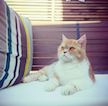 The data from Lil BUB is also freely available on their website, and you can go through her data and see a report or her micro biome.
The data from Lil BUB is also freely available on their website, and you can go through her data and see a report or her micro biome.
Jennifer tells us she has also made her cat's date available. His name is Danny. When they were looking for a comparator cat for a Little BUB, they thought they might as well use Danny. So Danny and his analysis contributed nine novel species to the wonderful world of microbiology. Between the two pets, you can explore 22 genomes from totally new bacteria, all things they haven't really observed before.
You will also find other data from other animals at their website. Many people have elected to share their pet's status so you can browse around and see how your pet compares to other pets. For example, is your pet healthy? Does your pet have lots of microbial diversity? Do they have less diversity? Its kind of empowering people to learn a little bit more about their pets.
They are also having a contest to name the newly discovered 22 new microorganisms. They are encouraging people to jump in with their suggested names and Jennifer is hoping that Danny, her cat, gets his name in there, perhaps "Clostridium Danny-i."
Visit Website
Engineering for Cats
Mac Delaney, Aerospace Engineer
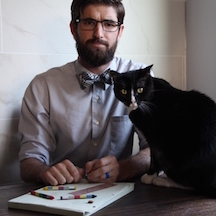 Aerospace Engineer Mac Delaney addresses the quirks of cat behavior. He's developed 10 DIY solutions for typical cat issues. During the day he's building aircraft parts. By night he's solving your cat's furniture scratching problem.
Aerospace Engineer Mac Delaney addresses the quirks of cat behavior. He's developed 10 DIY solutions for typical cat issues. During the day he's building aircraft parts. By night he's solving your cat's furniture scratching problem.
Mac Delaney is an aerospace engineer who works for a company that makes large engine components for commercial aircraft like the Boeing 787 and the Airbus 8350. So it's no surprise that he has written a book called, "Engineering For Cats," which addresses the oddities of cat behavior through the view of an aerospace engineer.
Mac lives with his two cats, Pepe and Nellie, who were the inspiration for his book, which consists of 10 cat-approved projects for humans to create for their cats that solve the most common sources of friction affecting cats and their doting owners. Each of the 10 different projects address a certain quirk or a different issue with the aspect of owning a cat, that can make just the whole process of living together a little bit more enjoyable.
One project is a cat fountain. It's no surprise that some cats really prefer moving water as opposed to a stagnant bowl. In Engineering For cats, you will find plans to build a fountain out of PVC pipe. Another popular project is a litter box cabinet, allowing you to hide your litter box in your living room without invading your cat's privacy too much.
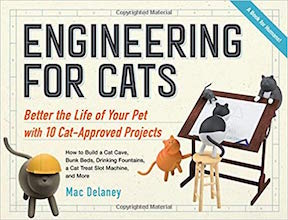 You will also find plans for the Cat Treat Slot Machine, which according to Mac is the most entertaining one to use. It is a simple build out of PVC pipe with three spinners your cat will have to figure out how to spin it around. Then there's a random chance whether or not a treat will fall out of it. He explains that this one took a lot of design iterations to find a puzzle that was not too complicated for his cats, but also not too easy for them. You can also calibrate this one, based on how you build it. You can make it more difficult if you have kind of a clever cat or if you have a cat more on the "not so clever" side, you can put it on easy mode for them as well. The time it takes to make this project, according to Mac, really depends on what you have a handy and your experience, but even if you're a definite beginner and figuring it all out for the first time, it should take no more than two or three hours.
You will also find plans for the Cat Treat Slot Machine, which according to Mac is the most entertaining one to use. It is a simple build out of PVC pipe with three spinners your cat will have to figure out how to spin it around. Then there's a random chance whether or not a treat will fall out of it. He explains that this one took a lot of design iterations to find a puzzle that was not too complicated for his cats, but also not too easy for them. You can also calibrate this one, based on how you build it. You can make it more difficult if you have kind of a clever cat or if you have a cat more on the "not so clever" side, you can put it on easy mode for them as well. The time it takes to make this project, according to Mac, really depends on what you have a handy and your experience, but even if you're a definite beginner and figuring it all out for the first time, it should take no more than two or three hours.
Mac explains that he has built all of the projects in his book originally to help him solve the problems he was having with his own cats. When his friends and family saw what he was doing, they also wanted him to build the projects for their cats. So rather than build it for them, he says he took the lazy option and just started making instructions so they could build them themselves.
So do you need to be an engineer to build these projects? Mac explained that they are definitely aimed at the beginner. They are a little bit more complicated than a standard craft and you do need to go to the hardware store. A couple of tools would also be good. He says all of the instructions are written assuming you have no experience. He has also included some technical information about the engineering behind each one. According to Mac, you can totally just ignore this section. He put it in there because he likes it and thinks its fun, but it's not necessary and your cat doesn't have to understand it either in order for them to use the projects.
 The 10 different projects are Simple Cat Shelf, Advanced Cat Shelf, Drinking Fountains, Cat Cave, Simple Scratcher, Bunk Beds, Cat Treat Slot Machine, Drawbridge Cat Door, Litter Box Cabinet and Cat Wheel, all designed for a different aspect of cat ownership. Mac has also included the costs to build these projects in relative terms, because costs of supplies can change depending upon where you live. He has ranked his projects by high, medium, low, and kind of gives a comparison in terms of how much cat food or cat veterinary trips that would cost you!
The 10 different projects are Simple Cat Shelf, Advanced Cat Shelf, Drinking Fountains, Cat Cave, Simple Scratcher, Bunk Beds, Cat Treat Slot Machine, Drawbridge Cat Door, Litter Box Cabinet and Cat Wheel, all designed for a different aspect of cat ownership. Mac has also included the costs to build these projects in relative terms, because costs of supplies can change depending upon where you live. He has ranked his projects by high, medium, low, and kind of gives a comparison in terms of how much cat food or cat veterinary trips that would cost you!
Visit Website
10th Annual Cross-Country Pet Adoption Tour: Get Your Licks on Route 66
Susan Sims, Fido Friendly Magazine
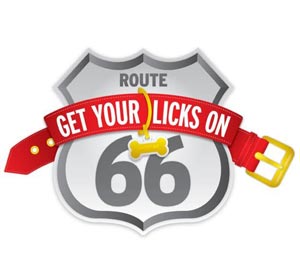 The Tenth Annual Get Your Licks on Route 66 Adoption Tour recently kicked off in Los Angeles. The Get Your Licks on Route 66 Adoption Tour is an annual cross-country pet adoption tour. They start in Los Angeles and go all the way to Chicago and work their way back. The tour is to help raise money for the shelters along the way and to raise awareness for the plight of these shelter animals. Their first 9 Get Your Licks on Route 66 Tours helped place over 10,000 pets into new forever homes.
The Tenth Annual Get Your Licks on Route 66 Adoption Tour recently kicked off in Los Angeles. The Get Your Licks on Route 66 Adoption Tour is an annual cross-country pet adoption tour. They start in Los Angeles and go all the way to Chicago and work their way back. The tour is to help raise money for the shelters along the way and to raise awareness for the plight of these shelter animals. Their first 9 Get Your Licks on Route 66 Tours helped place over 10,000 pets into new forever homes.
Today the tour takes them to Midwest City, Oklahoma. Susan brings her giant spinning filled with prizes donated by their sponsors. Sponsors include Nissan, Tito's Vodka, DogLeggs, PawPack, Petcurean, Buddy Belts, Hands On Gloves, Rolf C. Hagen, Embrace Pet Insurance Cosequin Joint Health Supplements, Petmate, Dexa, Canidae, Handicapped Pets, Shed Defender, Outward Hound, Charlee Bear, The Company of Animals, The Honest Kitchen, John Paul Pet, Blue Dog Bakery, Old Mother Hubbard, Affordable Allergy Testing, Royal Animals, PureLuxe Pet Food, Brilliant Pad, Bike Tow Leash, The Emergency Tag Help 4 Pets and Kurgo.
Today is the last day of the tour:
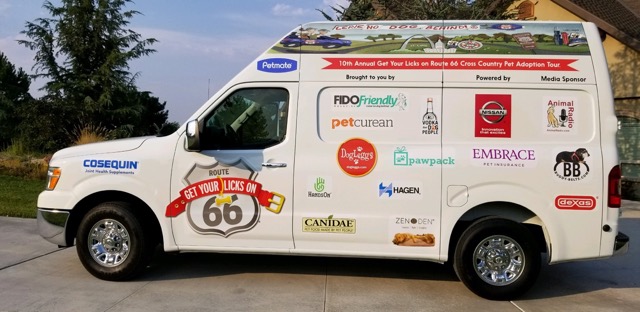 October 13
October 13
Kansas City, Missouri 2:00pm-6:00pm
Wayside Waifs, 3901 Martha Truman Rd., Kansas City, MO
Even if you are not planning on adopting a new family member, come on out and have some fun and see the animals. You can also win prizes on the spinning wheel, with donations going to your local shelter. It's a great way to support your local shelter and have fun at the same time.
Visit Website
When Pet Food Is Medicine - Dr. Debbie
 Proper pet nutrition is more than just diet choices for the healthy pet. It's even more important to properly feed the sick pet or those with chronic diseases. What you put in your pet's food bowl can help, or harm, his ability to cope with illness.
Proper pet nutrition is more than just diet choices for the healthy pet. It's even more important to properly feed the sick pet or those with chronic diseases. What you put in your pet's food bowl can help, or harm, his ability to cope with illness.
Peek into your average veterinary office and you'll likely find one or more brands of therapeutic diet foods created to manage pet specific pet health conditions. Veterinarians prescribe therapeutic diets to help pets with kidney disease, diabetes, pancreatitis, weight loss or heart disease. Special digestive diets may focus on hypoallergenic ingredients, fiber content or fat levels. Some diets prevent or dissolve mineralized stones in the urinary bladder. There are even diets to keep the spring in your arthritic dog's step and diets to aid in treating pets with cancer.
The grandfather of veterinary nutrition was Dr. Morris who in 1940 designed a diet to improve longevity of his dog, Buddy, who was a seeing-eye dog battling kidney disease. His efforts led to the introduction to Hill's K/D diet, a favorite diet used today for dogs and cats with kidney dysfunction. Today many more diets and conditions are addressed by companies such as Science Diet, Royal Canin, Purina and Iams.
As a veterinarian I recognize the value that therapeutic diets lend to managing my patients' health. But my strongest testament to their value is as a doggie momma who feeds a therapeutic diet to my own dog, Magnum.
My Labrador Magnum suffers from food allergies with frequent facial skin infections, bad skin odor, scratching and unpleasant gastrointestinal signs with diarrhea and flatulence. After several diet trials with various hypoallergenic diet approaches, he now thrives on a rabbit based therapeutic diet by Royal Canin. His doggie kisses are sweeter smelling now, he's content and he isn't a walking gaseous explosion anymore.
But be prepared to dig deeper in your wallet for therapeutic diets. The research behind these foods will cost the consumer more than average pet foods. Just look at the example of Magnum's food. This diet runs $86 for a 25-pound bag of dry food. This sure isn't cheap. But the investment can pay off in lower medical costs and fewer veterinary visits, justifying the additional cost. In Magnum's case, we are able to avoid continued treatment of skin infections, thereby avoiding medication use and he is spared incessant itching.
 Some pet owners turn to home cooked diets in order to avoid the costs of therapeutic diets. Without guidance and veterinary nutrition analysis, pet owners may risk shortchanging their pet's nutrition. One research study identified that over 90-percent of home prepared diets for sick pets failed to be nutritionally adequate. Quality ingredients aren't cheap and a well-produced home cooked diet often ends up costing far more to prepare than commercially produced therapeutic diets.
Some pet owners turn to home cooked diets in order to avoid the costs of therapeutic diets. Without guidance and veterinary nutrition analysis, pet owners may risk shortchanging their pet's nutrition. One research study identified that over 90-percent of home prepared diets for sick pets failed to be nutritionally adequate. Quality ingredients aren't cheap and a well-produced home cooked diet often ends up costing far more to prepare than commercially produced therapeutic diets.
If your veterinarian recommends nutritional management with a therapeutic diet, discuss all the options with your doctor. Inquire about different brands and sizes of food packages available, as many options are available. Get your money's worth on these diets by following your veterinarian's recommendations. Avoid mixing therapeutic diets with regular foods. This only hinders your pet's results and give you a false sense of saving money by making the food last longer.
As for Magnum, I choose to feed him his therapeutic diet and avoid popping pills into him. That's my gauge of a therapeutic diet success - food that serves like medicine in the doggie bowl, but without the hassles.
Featured veterinarian known as "Dr. Debbie" on national pet radio program, Animal Radio. Ebook author of "Yorkshire Terriers: How to Be Your Dog's Best Friend"; "Pugs: How to Be Your Dog's Best Friend"; "Mini Schnauzers: How to Be Your Dog's Best Friend"; and "Shih Tzu: How to Be Your Dog's Best Friend." Dr. Debbie's books.
Visit Website
Animal Radio News - Lori Brooks
 Do You Speak "Baby" Talk To Your Pet?
Do You Speak "Baby" Talk To Your Pet?
It has long been known that talking to a baby improves bonding between parent and child. But, since so many pet parents view their pets as their own children, scientists were wondering does talking to your dog in the same way as you would a human infant have the same bonding effect? A recent study suggests it does. Researchers Alex Benjamin and Katie Slocombe, at the University of York in the United Kingdom, set out to investigate if so-called dog-speak improves bonding between pets and humans, and specifically, whether it is useful for the dogs to hear that high pitched baby talk. They found that adult dogs were more likely to want to interact and spend time with the speaker that used dog-directed speech with dog-related content, than they did with those that used adult-directed speech with no dog-related content. And, when they mixed-up the two types of speech and content, the dogs showed no preference for one speaker over the other. That suggests that adult dogs need to hear dog-relevant words spoken in a high-pitched emotional voice in order to find it relevant. The study was published in the journal Animal Cognition.
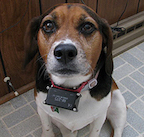 Shock Collars Banned in England
Shock Collars Banned in England
A ban on so-called pet "shock collars" will be enacted in England, under plans confirmed by the government. The shock collars, used to control pets, are usually controlled via a remote control and are already banned in Wales. Scotland has announced it is following England's lead with a ban of its own. This is similar to political battles that are happening in the US. Only in England, it's their political party called the Conservatives who are the animal rights supporters, while the country's Tory party would rather concentrate on their goal to bring back fox hunting and overturning a ban on ivory or elephant tusks. It's important to note that shock collars are often marketed as a harmless quick-fix solution or training aides, but animal experts say shock collars can easily cause more problems than they seek to fix.
Would You Buy These Treats?
There's a new dog treat headed to store shelves and the name alone might make you NOT want to buy it, but I bet dogs will love it. A woman in Kansas has a patent pending on the new treat called, "Mickey And Moe's Butt Flavored Dog Treats."
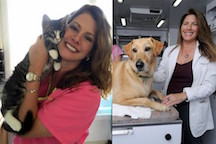 High Rate of Suicides Among Veterinarians
High Rate of Suicides Among Veterinarians
Santa Barbara, California is dealing with a crisis in its animal care community, which is a problem happening all over the country. The problem is the high rate of suicide among veterinarians. In fact, vets have the highest rate of suicide among all professional groups, four times higher than the national average. What has thrust this issue into the national spotlight is the recent suicides of two young female veterinarians in Santa Barbara. Each ran their own mobile practice giving at-home care to sick pets. Within months of each other, both women committed suicide, one late last year and the second one in early February. Their deaths shocked colleagues and clients, who said neither had shown any obvious signs of distress. But the deaths are reflective of a quiet crisis within the veterinary profession. Multiple studies in recent years have revealed disproportionately high rates of depression, anxiety and suicide among veterinarians in the United States. A Centers for Disease Control and Prevention survey of 10,000 practicing vets showed they displayed signs of serious mental illness and feelings of hopelessness and worthlessness, two to three times as often as the rest of the population. Similar statistics have been reported in Great Britain and Australia. Like their human-doctor counterparts, vets graduate from medical school with heavy student debt, but throughout their careers even the most accomplished will only earn about half of what human physicians make. Add that student debt to a mortgage, living expenses and mobile clinic van payments, and the financial burden can be overwhelming. Interestingly, many veterinarians talked about pressure from clients to perform services at no charge. Some out-of-line pet parents will say, "If you loved animals, you'd do it for free." The CDC survey results, based on answers from more than 10,000 practicing veterinarians, most (69-percent) of who are in small animal practice, revealed the following: 6.8-percent of males and 10.9-percent of females in the profession have serious psychological distress compared with 3.5-percent and 4.4-percent of U.S. male and female adults. 24.5-percent of males and 36.7-percent of females in veterinary medicine have experienced depressive episodes since veterinary school, which is about 1 and 1/2 times the prevalence in U.S. adults overall throughout their lifetime. 14.4-percent of males and 19.1-percent of females who are veterinarians have considered suicide since graduation. This is three times the U.S. national. This means that 1.1-percent of males and 1.4-percent of females in the veterinary profession have attempted suicide since veterinary school.
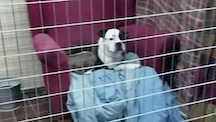 Shelters Are Starting to Look Like Home
Shelters Are Starting to Look Like Home
An Illinois animal shelter is giving its dogs and cats the feeling of living in a real home by furnishing their kennels with old chairs donated by the public. These include old recliners and big comfy chairs, where an animal can sleep the day away comfortably. The Knox County Humane Society No Kill Shelter in Galesburg recently posted a video on its Facebook page and it went viral. The director of the shelter said the chair project was inspired by a pit bull named Buster, who has a tendency to hop onto any available chair, even if it's occupied by a staff member. The shelter has since begun collecting unwanted recliners and armchairs to furnish the kennels for the dogs, because having a chair in the kennel really helps give the dogs more of a home setting while they're held at a shelter. Workers at the shelter say it's especially helped one of the dogs, named Mickey, with his stress levels. Mickey has been in their shelter about a year and his human furniture seems to give him a greater sense of security. Since the video debuted online they've received a lot of chair donations allowing even the cats to lounge in luxury in the shelter's free-roaming cat room.
 Listen to the entire Podcast of this show (#984)
Listen to the entire Podcast of this show (#984)





